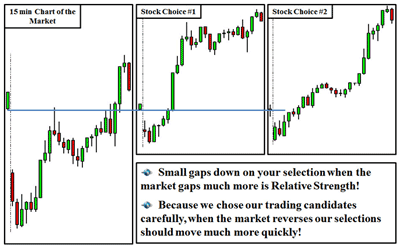Even stocks showing relative strength will gap down with the broader market, writes Ron Wagner of RevolutionaryTrading.com, and favorable long-entry opportunities are often presented as a result.
Many traders, like me when I first started trading, either have no clue what to trade or have far too many selections and don’t know what to do with them. After a great deal of backtesting in live cash trading, I found what works best under most market conditions. This has become one of my most favorite choices of trading styles over the past 12 years.
See also: 3 Signs a Stock Is Worth Trading
It is amazing to me how complicated we first try to make trading and investing. It took me a couple of years to finally figure out that it’s really the simple things and common sense that help me choose the best candidates to trade or invest in.
Sure, we have to go through a learning curve to know the basics of how to choose a trade, but to become consistent, I had to really simplify what I did on a daily basis. I find that so many make it much harder than it needs to be.
Below, you can see at the far left is a 15-minute chart of the market. The first green candle, and the blue line directly under it, is where resistance would be to fill the gap. That happened on the current day you are looking at.
I lined up two of my trading candidates for that day to give you a visual comparison. I had chosen each of those candidates for specific reasons on the long side, but had to re-evaluate the situation with the very aggressive gap down in the market.
Both of these stocks had gapped down minimally in sympathy with the market. Think of market makers and specialists as shopkeepers; the shopkeepers for stock #1 and stock #2 could get some cheaper shares from those putting in market orders before the market opened. Why not get cheaper inventory?
As the market fell further after the gap down, you can see that stock #1 did not move down as much. Stock #2 didn’t budge at all.
I had multiple entry possibilities on lower time frames for both stock choices as the market began to reverse. Stock #2, however, presented an opportunity on a shallow pullback in alignment with the market later in the day and produced an incredible upside move.
You can compare your selections by percentage change on gaps as compared to the market. I prefer the visual approach, as I can then also see how each candle is forming as compared to the market action developing.
I love trading in weaker markets because the largest number of traders and investors are looking for long opportunities and trading candidates that have relative strength will be very easy to find. We always want to be trading on the side of the majority, as we need others to buy our shares when we are ready to sell for a profit.
A lot more criteria are important to apply to our potential trading candidates, but that is beyond the scope of this article. Needless to say, it’s always best to be trading those candidates that have the most relative strength compared to the market.
Remember, the market is a composite, or average, of all stocks, so we can always find relatively weak or strong candidates to trade in the direction of the current market trends.
See also: Find Big Winners with Relative Strength
This same strategy, of course, can be used when trading on the short side.
Next time we meet, I will give an example where everything is gapping and moving up and what to look for under those conditions.
It’s just a matter of what kind of treasure you’re looking for and then sticking to your plan to find it!
By Ron Wagner, active trader, investor, and principal partner, RevolutionaryTrading.com





















